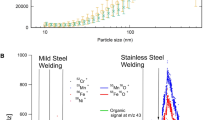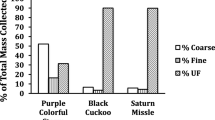Abstract
Thermal spray coating is an industrial process in which molten metal is sprayed at high velocity onto a surface as a protective coating. An automated electric arc wire thermal spray coating aerosol generator and inhalation exposure system was developed to simulate an occupational exposure and, using this system, male Sprague–Dawley rats were exposed to stainless steel PMET720 aerosols at 25 mg/m3 × 4 h/day × 9 day. Lung injury, inflammation, and cytokine alteration were determined. Resolution was assessed by evaluating these parameters at 1, 7, 14 and 28 d after exposure. The aerosols generated were also collected and characterized. Macrophages were exposed in vitro over a wide dose range (0–200 µg/ml) to determine cytotoxicity and to screen for known mechanisms of toxicity. Welding fumes were used as comparative particulate controls. In vivo lung damage, inflammation and alteration in cytokines were observed 1 day post exposure and this response resolved by day 7. Alveolar macrophages retained the particulates even after 28 day post-exposure. In line with the pulmonary toxicity findings, in vitro cytotoxicity and membrane damage in macrophages were observed only at the higher doses. Electron paramagnetic resonance showed in an acellular environment the particulate generated free radicals and a dose-dependent increase in intracellular oxidative stress and NF-kB/AP-1 activity was observed. PMET720 particles were internalized via clathrin and caveolar mediated endocytosis as well as actin-dependent pinocytosis/phagocytosis. The results suggest that compared to stainless steel welding fumes, the PMET 720 aerosols were not as overtly toxic, and the animals recovered from the acute pulmonary injury by 7 days.








Similar content being viewed by others
Data availability
The data from this project will be posted in the NIOSH Data and Statistics Gateway https://www.cdc.gov/niosh/data/default.html.
References
Afshari AA, McKinney W, Cumpston JL et al (2022) Development of a thermal spray coating aerosol generator and inhalation exposure system. Toxicol Rep 9:126–135. https://doi.org/10.1016/j.toxrep.2022.01.004
Antonini JM (2003) Health effects of welding. Crit Rev Toxicol 33(1):61–103. https://doi.org/10.1080/713611032
Antonini JM (2014) 8.04 - Health effects associated with welding. In: Hashmi S, Batalha GF, Van Tyne CJ, Yilbas B (eds) Comprehensive materials processing. Elsevier, Oxford, pp 49–70
Antonini JM, Stone S, Roberts JR et al (2007) Effect of short-term stainless steel welding fume inhalation exposure on lung inflammation, injury, and defense responses in rats. Toxicol Appl Pharmacol 223(3):234–245. https://doi.org/10.1016/j.taap.2007.06.020
Antonini JM, Roberts JR, Stone S et al (2011) Persistence of deposited metals in the lungs after stainless steel and mild steel welding fume inhalation in rats. Arch Toxicol 85(5):487–498. https://doi.org/10.1007/s00204-010-0601-1
Antonini JM, Roberts JR, Schwegler-Berry D, Mercer RR (2013) Comparative microscopic study of human and rat lungs after overexposure to welding fume. Ann Occup Hyg 57(9):1167–1179. https://doi.org/10.1093/annhyg/met032
Antonini JM, McKinney WG, Lee EG, Afshari AA (2021) Review of the physicochemical properties and associated health effects of aerosols generated during thermal spray coating processes. Toxicol Ind Health 37(1):47–58. https://doi.org/10.1177/0748233720977975
ASM Thermal spray technology white paper prepared by the Thermal Spray Society affiliate of ASM International. In: ASM Thermal Spray Society. http://www.asminternational.org/web/tss/technical/white-paper Accessed 09 2021
Behzadi S, Serpooshan V, Tao W et al (2017) Cellular uptake of nanoparticles: journey inside the cell. Chem Soc Rev 46(14):4218–4244. https://doi.org/10.1039/c6cs00636a
Bemer D, Regnier R, Subra I, Sutter B, Lecler MT, Morele Y (2010) Ultrafine particles emitted by flame and electric arc guns for thermal spraying of metals. Ann Occup Hyg 54(6):607–614. https://doi.org/10.1093/annhyg/meq052
Chadwick J, Wilson H, White M (1997) An investigation of occupational metal exposure in thermal spraying processes. Sci Total Environ 199(1–2):115–124
Darut G, Dieu S, Schnuriger B et al (2021a) State of the art of particle emissions in thermal spraying and other high energy processes based on metal powders. J Clean Prod 303:126952
dos Santos T, Varela J, Lynch I, Salvati A, Dawson KA (2011) Effects of transport inhibitors on the cellular uptake of carboxylated polystyrene nanoparticles in different cell lines. PLoS ONE 6(9):e24438. https://doi.org/10.1371/journal.pone.0024438
Falcone LM, Erdely A, Kodali V et al (2018) Inhalation of iron-abundant gas metal arc welding-mild steel fume promotes lung tumors in mice. Toxicology 409:24–32. https://doi.org/10.1016/j.tox.2018.07.007
Gérard B (2006) Application of thermal spraying in the automobile industry. Surf Coat Technol 201(5):2028–2031. https://doi.org/10.1016/j.surfcoat.2006.04.050
Graczyk H, Lewinski N, Zhao J et al (2016) Increase in oxidative stress levels following welding fume inhalation: a controlled human exposure study. Part Fibre Toxicol 13(1):31. https://doi.org/10.1186/s12989-016-0143-7
GrandViewResearch Thermal spray coatings market size worth $14.1 billion by 2028., vol 2021. Grand View Research
Hałatek T, Stanisławska M, Świercz R, Domeradzka-Gajda K, Kuraś R, Wąsowicz W (2018) Clara cells protein, prolactin and transcription factors of protein NF-ĸB and c-Jun/AP-1 levels in rats inhaled to stainless steel welding dust and its soluble form. Int J Occup Med Environ Health 31(5):613–632. https://doi.org/10.13075/ijomeh.1896.01234
Hardwicke CU, Lau Y-C (2013) Advances in thermal spray coatings for gas turbines and energy generation: a review. J Therm Spray Technol 22(5):564–576
Herman H, Sampath S, McCune R (2000) Thermal spray: current status and future trends. MRS Bull 25(7):17–25
Hicks R, Al-Shamma KJ, Lam HF, Hewitt PJ (1983) An investigation of fibrogenic and other toxic effects of arc-welding fume particles deposited in the rat lung. J Appl Toxicol 3(6):297–306. https://doi.org/10.1002/jat.2550030605
Huang H, Li H, Li X (2016) Physicochemical characteristics of dust particles in HVOF spraying and occupational hazards: case study in a Chinese company. J Therm Spray Technol 25(5):971–981. https://doi.org/10.1007/s11666-016-0422-8
IARC (2018) Welding, molybdenum trioxide, and indium tin oxide Working Group on the Evaluation of Carcinogenic Risks to Humans. vol 118. World Health Organization, p 36–265
Ibuki Y, Toyooka T (2012) Nanoparticle Uptake Measured by Flow Cytometry. In: Reineke J (ed) Nanotoxicity: Methods and Protocols. Humana Press, Totowa, NJ, pp 157–166
Kodali V, Thrall BD (2015) Oxidative stress and nanomaterial-cellular interactions. In: Roberts SM, Kehrer JP, Klotz L-O (eds) Studies on experimental toxicology and pharmacology. Springer International Publishing, Cham, Oxidative Stress in Applied Basic Research and Clinical Practice, pp 347–367
Kodali V, Littke MH, Tilton SC et al (2013) Dysregulation of macrophage activation profiles by engineered nanoparticles. ACS Nano 7(8):6997–7010. https://doi.org/10.1021/nn402145t
Kodali V, Shoeb M, Meighan TG et al (2020) Bioactivity of circulatory factors after pulmonary exposure to mild or stainless steel welding fumes. Toxicol Sci 177(1):108–120. https://doi.org/10.1093/toxsci/kfaa084
Leonard SS, Xia C, Jiang BH et al (2003) Resveratrol scavenges reactive oxygen species and effects radical-induced cellular responses. Biochem Biophys Res Commun 309(4):1017–1026. https://doi.org/10.1016/j.bbrc.2003.08.105
Leonard SS, Jenny R, James M, Castranova V, Shi X (2004) PbCrO 4 mediates cellular responses via reactive oxygen species. Mol Cell Biochem 255(1):171–179
Leonard SS, Chen BT, Stone SG et al (2010) Comparison of stainless and mild steel welding fumes in generation of reactive oxygen species. Part Fibre Toxicol 7(1):32. https://doi.org/10.1186/1743-8977-7-32
Lodovici M, Bigagli E (2011) Oxidative stress and air pollution exposure. Journal of Toxicology 2011:487074. https://doi.org/10.1155/2011/487074
Malek MHA, Saad NH, Abas SK, Shah NM Thermal arc spray overview. In: IOP Conference Series Materials Science and Engineering (Online), 2013. vol 46.
McCarrick S, Wei Z, Moelijker N et al (2019) High variability in toxicity of welding fume nanoparticles from stainless steel in lung cells and reporter cell lines: the role of particle reactivity and solubility. Nanotoxicology 13(10):1293–1309. https://doi.org/10.1080/17435390.2019.1650972
McNeilly J, Jimenez LA, Clay MF et al (2005) Soluble transition metals in welding fumes cause inflammation via activation of NF-kappaB and AP-1. Toxicol Lett 158(2):152–157. https://doi.org/10.1016/j.toxlet.2005.03.005
BLS Occupational employment and wages (2020) 51–924 Coating, painting, and spraying machine setters, operators, and tenders. In: U.S. Bureau of Labor Statistics. https://data.bls.gov/cgi-bin/print.pl/oes/current/oes519121.htm Accessed 08 2021
Oerlikon An introduction to thermal spray. In: Oerlikon Metco. https://www.oerlikon.com/ecomaXL/files/metco/oerlikon_BRO-0005.6_Thermal_Spray_Brochure_EN.pdf Accessed 09 2021
Petsas N, Kouzilos G, Papapanos G, Vardavoulias M, Moutsatsou A (2007) Worker exposure monitoring of suspended particles in a thermal spray industry. J Therm Spray Technol 16(2):214–219. https://doi.org/10.1007/s11666-007-9027-6
Plummer EM, Manchester M (2013) Endocytic uptake pathways utilized by CPMV nanoparticles. Mol Pharm 10(1):26–32. https://doi.org/10.1021/mp300238w
Rennick JJ, Johnston APR, Parton RG (2021) Key principles and methods for studying the endocytosis of biological and nanoparticle therapeutics. Nat Nanotechnol 16(3):266–276. https://doi.org/10.1038/s41565-021-00858-8
Riccelli MG, Goldoni M, Poli D, Mozzoni P, Cavallo D, Corradi M (2020) Welding fumes, a risk factor for lung diseases. Int J Environ Res Public Health 17(7):2552. https://doi.org/10.3390/ijerph17072552
Shoeb M, Kodali V, Farris B et al (2017) Evaluation of the molecular mechanisms associated with cytotoxicity and inflammation after pulmonary exposure to different metal-rich welding particles. Nanotoxicology 11(6):725–736. https://doi.org/10.1080/17435390.2017.1349200
Stefaniak AB, Harvey CJ, Bukowski VC, Leonard SS (2009) Comparison of free radical generation by pre-and post-sintered cemented carbide particles. J Occup Environ Hyg 7(1):23–34
Suzuki H, Toyooka T, Ibuki Y (2007) Simple and easy method to evaluate uptake potential of nanoparticles in mammalian cells using a flow cytometric light scatter analysis. Environ Sci Technol 41(8):3018–3024. https://doi.org/10.1021/es0625632
Vranic S, Boggetto N, Contremoulins V et al (2013) Deciphering the mechanisms of cellular uptake of engineered nanoparticles by accurate evaluation of internalization using imaging flow cytometry. Part Fibre Toxicol 10(1):2. https://doi.org/10.1186/1743-8977-10-2
Zeidler-Erdely PC, Kashon ML, Li S, Antonini JM (2010) Response of the mouse lung transcriptome to welding fume: effects of stainless and mild steel fumes on lung gene expression in A/J and C57BL/6J mice. Respir Res 11(1):1–18. https://doi.org/10.1186/1465-9921-11-70
Zeidler-Erdely PC, Falcone LM, Antonini JM (2019) Influence of welding fume metal composition on lung toxicity and tumor formation in experimental animal models. J Occup Environ Hyg 16(6):372–377. https://doi.org/10.1080/15459624.2019.1587172
Zucker RM, Massaro EJ, Sanders KM, Degn LL, Boyes WK (2010) Detection of TiO2 nanoparticles in cells by flow cytometry. Cytometry A 77(7):677–685. https://doi.org/10.1002/cyto.a.20927
Funding
Funding was provided by the National Institute for Occupational Safety and Health project # 93909NE and National Institute of Health funding R01 ES031253.
Author information
Authors and Affiliations
Corresponding author
Ethics declarations
Conflict of interest
All the authors declare that they have no competing interests.
Additional information
Publisher's Note
Springer Nature remains neutral with regard to jurisdictional claims in published maps and institutional affiliations.
Rights and permissions
About this article
Cite this article
Kodali, V., Afshari, A., Meighan, T. et al. In vivo and in vitro toxicity of a stainless-steel aerosol generated during thermal spray coating. Arch Toxicol 96, 3201–3217 (2022). https://doi.org/10.1007/s00204-022-03362-7
Received:
Accepted:
Published:
Issue Date:
DOI: https://doi.org/10.1007/s00204-022-03362-7




